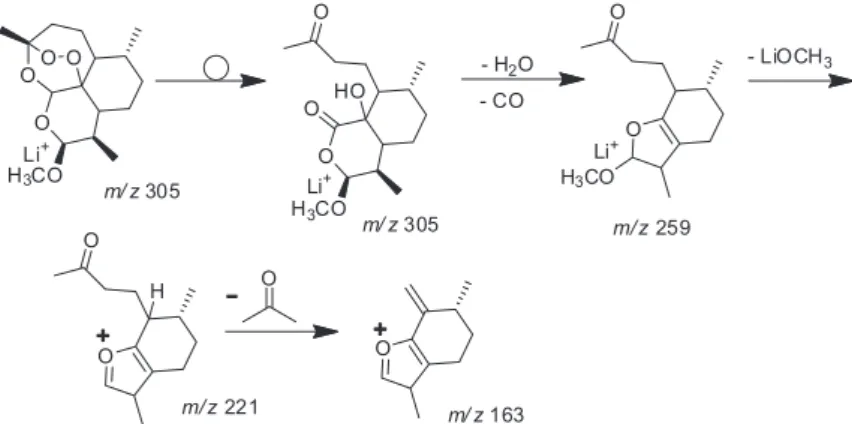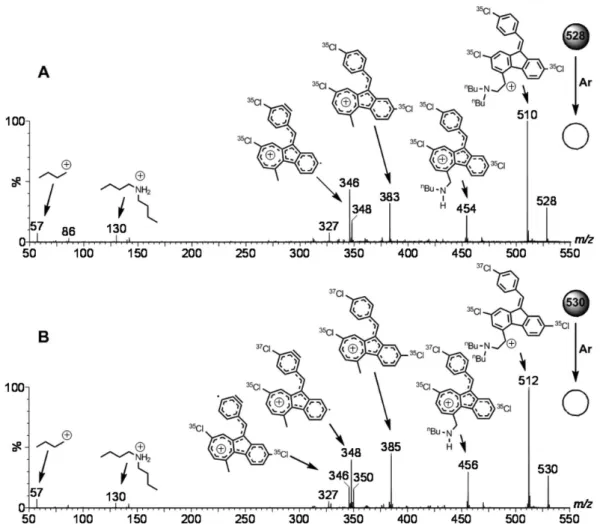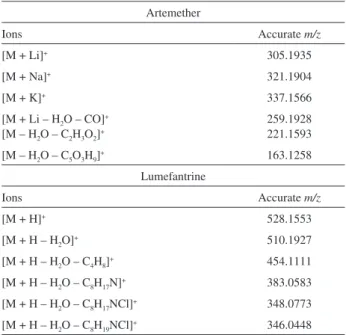Article
J. Braz. Chem. Soc., Vol. 23, No. 1, 65-71, 2012. Printed in Brazil - ©2012 Sociedade Brasileira de Química
0103 - 5053 $6.00+0.00
A
*e-mail: isaccesar@bol.com.br
Electrospray Ionization Tandem Mass Spectrometry of the Two Main
Antimalarial Drugs: Artemether and Lumefantrine
Vanessa G. dos Santos,a Ricardo J. Alves,b Marcos N. Eberlin,a Gerson A. Pianettib and Isabela C. César*,b
aInstituto de Química, Universidade Estadual de Campinas, Cidade Universitária Zeferino Vaz,
13083-970 Campinas-SP, Brazil
bFaculdade de Farmácia, Universidade Federal de Minas Gerais, Av. Pres. Antônio Carlos 6627,
31270-901 Belo Horizonte-MG, Brazil
Ionização por electrospray no modo de íons positivos, e espectrometria de massas de alta resolução e exatidão, e em tandem, realizadas em espectrômetro de massas híbrido quadrupolo e tempo de vôo, foram utilizadas para investigar a dissociação química das moléculas intactas dos dois antimaláricos mais amplamente utilizados: artemeter e lumefantrina. As rotas de dissociação das formas cationizadas e protonadas foram claramente estabelecidas via determinações de massas de alta resolução e distribuição isotópica. Os resultados obtidos podem auxiliar a monitorização e a quantificação de artemeter e lumefantrina por LC-MS/MS, assim como de novos derivados ou outros fármacos antimaláricos estruturalmente relacionados.
Electrospray ionization in the positive ion mode and high resolution and high accuracy tandem mass spectrometry performed in a hybrid quadrupole time-of-flight mass spectrometer were used to investigate the dissociation chemistry of the intact molecules of two most widely used antimalarial drugs: artemether and lumefantrine. The dissociation pathways of their cationized and protonated forms were rationalized based on high accuracy mass measurements and isotopic distributions. The obtained results should benefit LC-MS/MS monitoring and quantitation by mass spectrometry of the artemether and lumefantrine molecules, as well as of new derivatives or other structurally related antimalarial drugs.
Keywords:artemether, lumefantrine, ion dissociation, tandem mass spectrometry, ESI-MS/MS
Introduction
Artemether-lumefantrine is a drug association currently of wide use for malaria treatment. The registered fixed dose combination is commercialized in tablets that contain 20 mg of artemether and 120 mg of lumefantrine.1 The World
Health Organization (WHO) recommends this association as first line therapy for falciparum malaria in endemic areas, mainly when cases of resistance against traditional drugs are reported.2 Artemether (Scheme 1) is a semisynthetic derivative
of artemisinin, a natural product of the Chinese herb Artemisia annua,3 whereas lumefantrine (Scheme 1) is a synthetic
racemic fluorene derivative originally named benflumetol.4
Counterfeiting or drugs with substandard antimalarial doses are however major problems of worldwide occurrence
that dramatically affects the efficacy of malarial treatment. Ineffective or poor quality drugs is of great concern since their use may contribute to the development ofplasmodium resistance in malaria endemic areas, due to the exposition to subtherapeutic doses.5,6 The development of useful and
reliable methods for the identification of antimalarials is therefore essential to evaluate the quality of the antimalarial pharmaceutical preparations.
Chromatographic methods for the analysis of artemether and lumefantrine have been reported, focusing on the quantitation of these drugs in pharmaceutical products7 or
biological matrices.8,9 HPLC with UV detection is the most
common analytical method employed for lumefantrine,10,11
whereas for artemether, electrochemical12,13 or ultraviolet
detection after acid hydrolysis14 have been reported. Studies
employing mass spectrometry (MS) to quantify these drugs have used electrospray ionization for lumefantrine9,15,16 and
atmospheric pressure chemical ionization for artemether.17,18
Quantitation was the main focus of these studies, therefore product ions and dissociation routes of these drugs by tandem mass spectrometry were not thoughtfully evaluated.
The determination of the dissociation pathways of these main antimalarial drugs should benefit their monitoring by MS techniques in pharmaceutical products and biological fluids and the proper identification of artemether and lumefantrine derivatives and analogues. Herein we described our results of an investigation via electrospray ionization and tandem mass spectrometry performed in a high resolution and high accuracy hybrid quadrupole time-of-flight mass spectrometer of the dissociation chemistry of the protonated or cationized molecules of artemether and lumefantrine.
Experimental
Materials
Artemether and lumefantrine reference standards were purchased from Dafra Pharma (Turnhout, Belgium). Ultra-pure water was obtained from a Millipore system (Bedford, MA, USA). Methanol (HPLC grade) was purchased from Tedia (Fairfield, OH, USA) and formic acid (analytical grade) was from J. T. Baker (Phillipsburg, NJ, USA).
Mass spectrometry
The mass spectrometry experiments were performed using a hybrid quadrupole time-of-flight (Q-TOF) mass
spectrometer (Micromass, Manchester, UK). The ionization technique used was electrospray ionization (ESI) in the positive ion mode. Typical MS conditions were: capillary voltage of 3 kV, cone voltage of 30 V, source temperature of 100 °C, desolvation temperature of 100 °C.
Acidic solutions of the drugs were prepared in water/ methanol (1:1) containing 0.1% formic acid. These solutions were infused using a syringe pump (Harvard Apparatus) at a flow rate of 5 µL min-1. ESI-MS were acquired along the
50-1000 m/z range. ESI-MS/MS experiments were done by selecting the ion of interest using the first mass analyzing quadrupole. The selected ion was in turn subjected to 5-40 eV collisions with argon in the collision cell whereas the orthogonal TOF mass analyzer was used to acquire the ESI-MS/MS data. External calibration with a phosphoric acid solution was employed.
Results and Discussion
Artemether
Previous reports on the MS detection of the artemether molecule18,19 have reported on the failure to observe
the intact protonated molecule and used therefore only fragments and secondary dissociations for its quantitation. We also found that ESI-MS of an acid methanolic solution of artemether detects none of its protonated molecule [M + H]+ and only fragments were observed. A minor ion
of m/z 281, [M + H – H2O]+, has been detected probably
due to dissociation by water loss of the protonated molecule [M + H]+ of m/z 299. Secure quantitation of drugs is ideally
performed via ions formed from the intact molecule. We therefore dissolved the artemether molecule in methanol and doped the resulting solution with lithium chloride hoping to favor the detection of the intact molecule in its cationized form [M + Li]+. Figure 1 shows the resulting
ESI(+)-MS for this methanolic solution. The protonated molecule [M + H]+ of m/z 299 is again absent. The main
ions are [M + Li]+ of m/z 305, [M + Na]+ of m/z 321 and
[M + K]+ of m/z 337 as well as the corresponding dimers
[M2 + Li]+ of m/z 603 and [M2 + Na]+ of m/z 619. Na+ and
K+ are likely therefore present due to solvent contaminants
or from the original sample. Multiple cationization is not ideal for quantitation but allowed us to study, for the first time, the dissociation chemistry of the intact molecule in several of its cationized forms, as well as to double check the proposed routes, see below. The [M + Li]+ ion of
m/z 305, [M + Na]+ of m/z 321 and [M + K]+ of m/z 337 were
therefore selected and dissociated by collisions with argon (Figure 2). Scheme 2 rationalizes the main dissociation routes for [M + Li]+ of m/z 305. The first process is likely
isomerization of the Li+ adduct via the rupture of the labile
artemether peroxide ring. Loss of H2O and CO then occurs
to produce the fragment ion of m/z 259. Subsequently, loss
of a neutral LiOCH3 forms the product ion of m/z 221,
which dissociates in turn by the loss of acetone to form the ion of m/z 163. Shi et al.18 and Xing et al.19 also found an
ion of m/z 163 for the ESI-MS of artemether and proposed a distinct chemical structure for it based on a different mechanistic rationalization. We however favor the routes outlined in Scheme 2.
The concomitant formation via ESI of the Li+, K+
and Na+ adducts of the intact artemether molecule was
beneficial since it permits us to double check the accuracy of our proposed dissociation routes (Scheme 2). Indeed, the dissociation observed in the ESI-MS/MS of the Na+
(Figure 2B) and K+ adducts (Figure 2C) were analogous and
fully consistent with the proposed routes. The fragments of m/z 163 and 221 were, as expected, shared by the three cationized molecules whereas the major cationized fragments in Figure 2 (of m/z 259 for Li+ and m/z 275
for Na+) display the corresponding m/z shifts (16 units
from Li+ to Na+). In LC-MS/MS monitoring of this drug,
therefore, extensive cationization (by either Li+, Na+ or K+)
is recommended whereas the fragment ions of m/z 259 (for Li+) and 163 appears to be ideal for the quantitation and
confirmation MRM transitions, respectively. The source
conditions should also be tuned to reduce the abundance of the dimers such as [M2 + Li]+ via in-source CID.
Lumefantrine
Contrary to the artemether molecule, the protonated molecule of lumefantrine seems to be of high stability since an acidic water/methanol (1:1) solution of this drug (0.1% of formic acid) yielded a ESI(+)-MS dominated by an abundant and nearly exclusive set of the [M + H]+
splitted in its expected isotopologue ions (Figure 3). Note in the insert of Figure 3 the quite characteristic isotopologue distribution due to the presence of three chlorine atoms with 35Cl and 37Cl isotopes. The ions of m/z 560 and 592
correspond to the methanol adducts [M + CH3OH + H] +
and [M + 2CH3OH + H]+, respectively.
The ESI-MS/MS for protonated lumefantrine, as represented in Figure 4 for its isotopologue ions of m/z 528 and 530, showed rich dissociation chemistry. Water loss is the most favored initial dissociation forming (for the ion of m/z 528, Figure 4A) the major fragment ion of m/z 510. This elimination is likely favored due to the formation of a highly stable, fully delocalized, resonance stabilized
Figure 3. ESI(+)-MS of an acidified water:methanol solution of lumefantrine.
Figure 4. ESI(+)-MS/MS of the isotopologue ions of protonated lumefantrine of (A) m/z 528 and (B) m/z 530.
benzyl-like cation, which may rearranges to a tropylium-like ion (Scheme 3).20 Dissociation then proceeds at the
side chains and the next loss occurs by the elimination of a neutral butene molecule to form the ion of m/z 454, and then by the loss of an imine (1-butanimine) to form the ion of m/z 383. With apparently no favored route available for the elimination of a neutral molecule, dissociation then proceeds against the even-electron rule21 by the loss of
a chlorine radical (m/z 348) and then by the loss of a H2
molecule (m/z 346).
The set of 35Cl/37Cl isotopologue ions for protonated
lumefantrime (Figure 3) also permitted us to double check the proposed dissociation route (Scheme 4) using “natural” isotopic labeling via the selection and dissociation of the ions of m/z 528 (35Cl
3), 530 ( 35Cl
2
37Cl) and 532 (35Cl37Cl 2).
The ESI-MS/MS data fully confirmed the proposed routes via the observation of the corresponding m/z shifts due to the presence (or loss) of species bearing 37Cl or 35Cl
atoms, as exemplified for the ion of m/z 530 in Figure 4B. Note that all structural assignments of fragment ions have been corroborated by the m/z values measured with high accuracy (Table S1- Supplementary Information).
Therefore, for the LC-MS/MS quantitation of lumefantrine, MRM seems to be ideal via the selection of the pair of abundant isotopolgue ions of m/z 528 and 530 and the monitoring of the transition due to water loss (m/z 510 and 512, respectively) while using the dissociation by water plus butene plus Cl (m/z 383 and 385, respectively) for confirmation.
Conclusions
Using ESI(+) and high-resolution and high accuracy MS/MS performed in a hybrid quadrupole time-of-flight mass spectrometer, the dissociation chemistry of the cationized (Li+, Na+ and K+) molecule of artemether and
Scheme 3. Proposed fragmentation pathway for protonated lumefantrine.
Supplementary Information
Supplementary data are available free of charge at http://jbcs.sbq.org.br as PDF file.
Acknowledgments
We thank the following Brazilian Science foundations, FAPESP, FAPEMIG, and CNPq, for financial assistance.
References
1. Omari, A. A.; Gamble, C.; Garner, P.; Trop. Med. Int. Health
2004,9, 192.
2. World Health Organization; Antimalarial Drug Combination Therapy, Report of a WHO Technical Consultation, WHO: Geneva, 2001.
3. Hien, T. T.; Davis, T. M.; Chuong, L. V.; Ilett, K. F.; Sinh, D. X.; Phu, N. H.; Agus, C.; Chiswell, G. M.; White, N. J.; Farrar, J.; Antimicrob. Agents Chemother. 2004,48, 4234.
4. White, N. J.; Van Vugt, M.; Ezzet, F.; Clin. Pharmacokinet.
1999,37, 105.
5. Green, M. D.; Mount, D. L.; Wirtz, R. A.; Trop. Med. Int. Health
2001,6, 980.
6. Atemnkeng, M. A.; De Cock, K.; Plaizier-Vercammen, J.; Trop. Med. Int. Health 2007,12, 68.
7. César, I. C.; Nogueira, F. H. A.; Pianetti, G. A.; J. Pharm. Biomed. Anal. 2008,48, 951.
8. Hodel, E. M.; Zanolari, B.; Mercier, T.; Biollaz, J.; Keiser, J.; Olliaroc, P.; Gentona, B.; Decosterd, L. A.; J. Chromatogr., B: Anal. Technol. Biomed. Life Sci. 2009,877, 867.
9. César, I. C.; Ribeiro, J. A. A.; Teixeira, L. S.; Bellorio, K. B.; Abreu, F. C.; Moreira, J. M.; Chellini, P. R.; Pianetti, G. A.; J. Pharm. Biomed. Anal. 2011,54, 114.
10. Mansor, S. M.; Navaratnam, V.; Yahaya, N.; Nair, N. K.; Wernsdorfer, W. H.; Degen, P. H.; J. Chromatogr., B: Anal. Technol. Biomed. Life Sci. 1996, 682, 321.
11. Zeng, M.; Lu, Z.; Yang, S.; Zhang, M.; Liao, J.; Liu, S.; Teng, X.; J. Chromatogr., B: Anal. Technol. Biomed. Life Sci. 1996, 681, 299.
12. Navaratnam, V.; Mansor, S. M.; Chin, L. K.; Mordi, M. N.; Asokan, M.; Nair, N. K.; J. Chromatogr., B: Anal. Technol. Biomed. Life Sci. 1995,669, 289.
13. Karbwang, J.; Na-Bangchang, K.; Molunto, P.; Banmairuroi, V.; Congpuong, K.; J. Chromatogr., B: Anal. Technol. Biomed. Life Sci. 1997,690, 259.
14. Thomas, C. G.; Ward, S. A.; J. Chromatogr., B: Anal. Technol. Biomed. Life Sci.1992,583, 131.
15. Wahajuddin; Singh, S. P.; Jain G. K.; J. Chromatogr., B: Anal. Technol. Biomed. Life Sci. 2009,877, 1133.
16. Liu, T. ; Du, F. ; Wan, Y. ; Zhu, F. ; Xing, J.; J. Mass Spectrom.
17. Souppart, C.; Gauducheau, N.; Sandrenan, N.; Richard, F.; J. Chromatogr., B: Anal. Technol. Biomed. Life Sci. 2002, 774, 195.
18. Shi, B.; Yu, Y.; Li, Z.; Zhang, L.; Zhong, Y.; Su, S.; Liang, S.; Chromatographia 2006, 64, 523.
19. Xing, J.; Yan, H.; Zhang, S.; Ren, G.; Gao, Y.; Rapid Commun. Mass Spectrom. 2006,20, 1463.
20. Mendes, M. A.; Rittner, R.; Suwinski, J.; Szczepankiewicz, W.; Eberlin, M. N.; Eur. J. Mass Spectrom. 2002,8, 27.
21. Karni, M.; Mandelbaum, A.; Org. Mass Spectrom. 1980,15, 53.
Submitted: May 25, 2011
Published online: October 18, 2011
Supplementary Information
Printed in Brazil - ©2012 Sociedade Brasileira de Química0103 - 5053 $6.00+0.00S
I
*e-mail: isaccesar@bol.com.br
Electrospray Ionization Tandem Mass Spectrometry of the Two Main
Antimalarial Drugs: Artemether and Lumefantrine
Vanessa G. dos Santos,a Ricardo J. Alves,b Marcos N. Eberlin,a Gerson A. Pianettib and Isabela C. César*,b
aInstituto de Química, Universidade Estadual de Campinas, Cidade Universitária Zeferino Vaz,
13083-970 Campinas-SP, Brazil
bFaculdade de Farmácia, Universidade Federal de Minas Gerais, Av. Pres. Antônio Carlos 6627,
31270-901 Belo Horizonte-MG, Brazil
Table S1. Ions and their accurate m/z values detected in the ESI(+)-MS
Artemether
Ions Accurate m/z
[M + Li]+ 305.1935
[M + Na]+ 321.1904
[M + K]+ 337.1566
[M + Li – H2O – CO]+
[M – H2O – C2H3O2]+
259.1928 221.1593
[M – H2O – C5O3H9]+ 163.1258
Lumefantrine
Ions Accurate m/z
[M + H]+ 528.1553
[M + H – H2O]+ 510.1927
[M + H – H2O – C4H8]+ 454.1111
[M + H – H2O – C8H17N]+ 383.0583
[M + H – H2O – C8H17NCl]+ 348.0773

![Figure 2. ESI(+)-MS/MS of the (A) [M + Li] + , (B) [M + Na] + and (C) [M + K] + aducts of artemether.](https://thumb-eu.123doks.com/thumbv2/123dok_br/18996821.462468/3.892.158.760.265.1103/figure-esi-ms-ms-li-na-aducts-artemether.webp)


